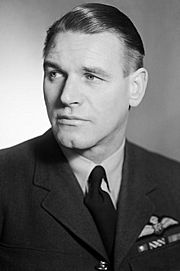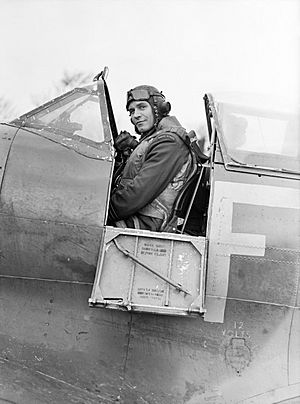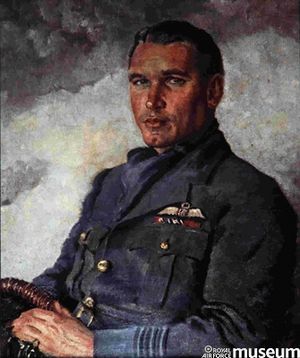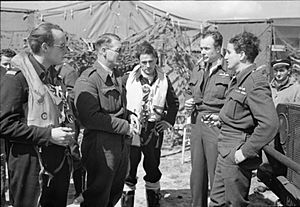Sailor Malan facts for kids
Quick facts for kids
Adolph Gysbert "Sailor" Malan
|
|
|---|---|

Group Captain Sailor Malan c. 1945
|
|
| Nickname(s) | Sailor |
| Born | 3 October 1910 Wellington, Cape Province |
| Died | 17 September 1963 (aged 52) Kimberley, Cape Province, South Africa |
| Buried |
West End Cemetery, Kimberley
|
| Allegiance | United Kingdom |
| Service/ |
Royal Navy Royal Air Force |
| Years of service | 1932–1946 |
| Rank | Group Captain |
| Commands held | No. 145 (Free French) Fighter Wing No. 19 Wing RAF No. 74 Squadron RAF |
| Battles/wars | Second World War |
| Awards | Distinguished Service Order & Bar< Distinguished Flying Cross & Bar Croix de guerre (Belgium) War Cross (Czechoslovakia) Legion of Honour (France) Croix de guerre (France) |
Adolph Gysbert Malan, known as Sailor Malan, was a brave South African fighter pilot who flew for the Royal Air Force (RAF) during the Second World War. He was a top pilot, also called a flying ace, and led No. 74 Squadron RAF during the famous Battle of Britain. By the end of his flying career in 1941, he had shot down many enemy planes. He was one of the highest-scoring pilots in the RAF's Fighter Command during the war.
After the war, Sailor Malan went back to South Africa. In the 1950s, he became a leader of the Torch Commando. This group stood against the unfair system called apartheid, which separated people based on their race.
Contents
Sailor Malan was born on October 3, 1910, in Wellington, Western Cape, South Africa. His family were Afrikaners, with roots from the Huguenots. When he was 14, he joined a naval training ship called the General Botha.
In 1928, he became an officer cadet on a ship named the Landsdown Castle. This time at sea is how he got his nickname "Sailor" from his pilot friends later on. In 1932, he joined the Royal Naval Reserve.
Joining the Royal Air Force
In 1935, the Royal Air Force (RAF) was growing fast and needed more pilots. Sailor Malan volunteered to join. He learned to fly the de Havilland Tiger Moth plane near Bristol. He took his first flight on January 6, 1936.
By the end of that year, he had finished his training and joined 74 Squadron. He quickly moved up in rank, becoming a pilot officer in 1937 and a flying officer in 1938. Six months before the war started, he was promoted to flight lieutenant.
Sailor Malan also created the "Ten Rules for Air Fighting". These rules helped other fighter pilots learn how to be successful in air battles.
Second World War Battles
The Battle of Barking Creek

Soon after the war began, on September 6, 1939, something confusing happened. Malan's 74 Squadron was sent to stop enemy planes, but they accidentally met other RAF planes. Believing they were the enemy, Malan ordered his pilots to attack.
Two RAF planes were shot down by mistake, and one officer died. This event became known as the Battle of Barking Creek. In the investigation that followed, the court decided it was an unfortunate error. Both pilots involved were found not guilty.
Fighting Over Dunkirk
During the evacuation of British soldiers from Dunkirk in May 1940, Sailor Malan fought bravely. He shot down five enemy planes and was given the Distinguished Flying Cross (DFC) award.
One night in June, he flew in bright moonlight and shot down two Heinkel He 111 bombers. This was a very rare achievement at the time. Because of this, he received a bar for his DFC, meaning he got the award a second time.
Malan and his pilots also changed how they flew in battle. They stopped using the old "Vic formation" and started using a looser "finger-four" formation. This was similar to what the German Luftwaffe pilots used.
Leading 74 Squadron
On August 8, 1940, at the peak of the Battle of Britain, Malan was given command of 74 Squadron. He was promoted to acting squadron leader. Just three days later, on August 11, his squadron had a very busy day. They intercepted several enemy raids near Dover.
By the end of that day, 74 Squadron claimed to have shot down 38 enemy aircraft. This amazing day became known as "Sailor's August the Eleventh." Malan received another bar to his DFC on August 13.
In 1941, Sailor Malan was one of the few airmen to have his portrait painted in colour by Cuthbert Orde, a famous artist who drew RAF pilots.
Becoming a Wing Commander
On December 24, Malan received the Distinguished Service Order, a very important award. In 1941, he became one of the first "wing leaders" for offensive operations. He led the Biggin Hill Wing until mid-August.
He ended his active fighter career in 1941. He was one of the highest-scoring pilots in Fighter Command during the war. After some other roles, Malan was promoted to temporary wing commander in September 1942. He then became the commander of RAF Biggin Hill air base.
Fighting Against Apartheid
After the war ended in 1946, Sailor Malan left the Royal Air Force. He kept his rank of group captain and went back to South Africa to become a sheep farmer.
He stayed connected to the RAF community and became president of the Royal Air Forces Association in South Africa. In the early 1950s, Malan became involved in South African politics. The National Party government had introduced apartheid, a system that unfairly separated people by race and gave white people more rights.
Sailor Malan strongly disagreed with apartheid. He joined a group called the Torch Commando, which protested against these new laws. Because he was a war hero, he was chosen as the group's president. The Torch Commando held large rallies where people carried flaming torches. At one point, the group had 250,000 members. Malan often spoke at these rallies.
Over time, the Torch Commando lost members as some joined other groups. Malan eventually left politics, and the National Party continued to rule South Africa for many more years.
Death
Sailor Malan passed away on September 17, 1963, at the age of 53. He died from Parkinson's disease, which was not well understood at the time. Money was raised in his name to help study the disease.
His funeral was held in Kimberley. Because of his strong opposition to apartheid, the South African government tried to make his funeral less important. They did not allow it to be a military funeral, and military personnel who attended were told not to wear their uniforms. The South African Air Force was also told not to give any tribute to him.
Awards and Decorations
 Distinguished Service Order and Bar (DSO & Bar)
Distinguished Service Order and Bar (DSO & Bar) Distinguished Flying Cross and Bar (United Kingdom) (DFC & Bar)
Distinguished Flying Cross and Bar (United Kingdom) (DFC & Bar) 1939-45 Star with Battle of Britain Clasp
1939-45 Star with Battle of Britain Clasp Air Crew Europe Star with France & Germany Clasp
Air Crew Europe Star with France & Germany Clasp Defence Medal (United Kingdom)
Defence Medal (United Kingdom) War Medal 1939 – 1945 (Mentioned in Dispatches) (MID)
War Medal 1939 – 1945 (Mentioned in Dispatches) (MID) Légion d'honneur (Officer - Officier) (France) (Ordre national de la Légion d'honneur)
Légion d'honneur (Officer - Officier) (France) (Ordre national de la Légion d'honneur) Croix de Guerre 1939–1945 (France)
Croix de Guerre 1939–1945 (France) Croix de Guerre (Belgium)
Croix de Guerre (Belgium) Czechoslovak War Cross 1939 Ribbon
Czechoslovak War Cross 1939 Ribbon
Sailor Malan in Movies
In the 1969 movie Battle of Britain, the character of Squadron Leader Skipper, played by Robert Shaw, was based on Sailor Malan.
See Also
- List of top World War II aces
- List of World War II aces from South Africa
- Huguenots in South Africa, for the history of French surnames (like Malan) in South Africa.



